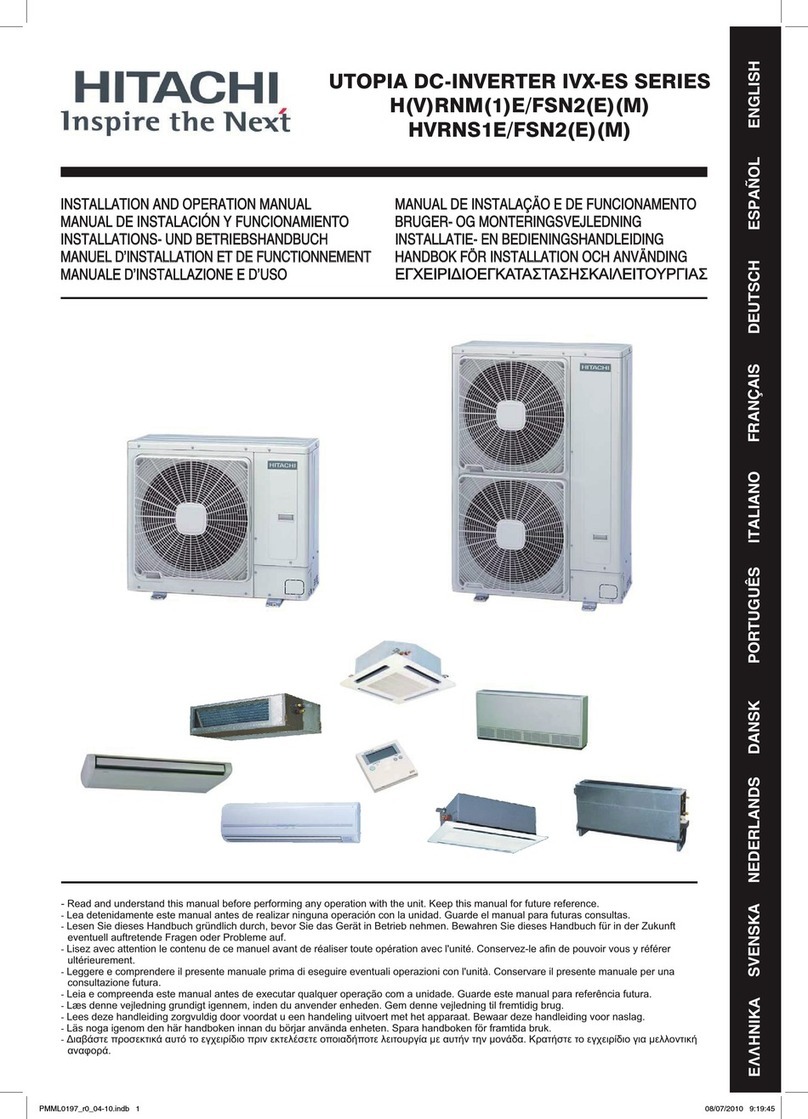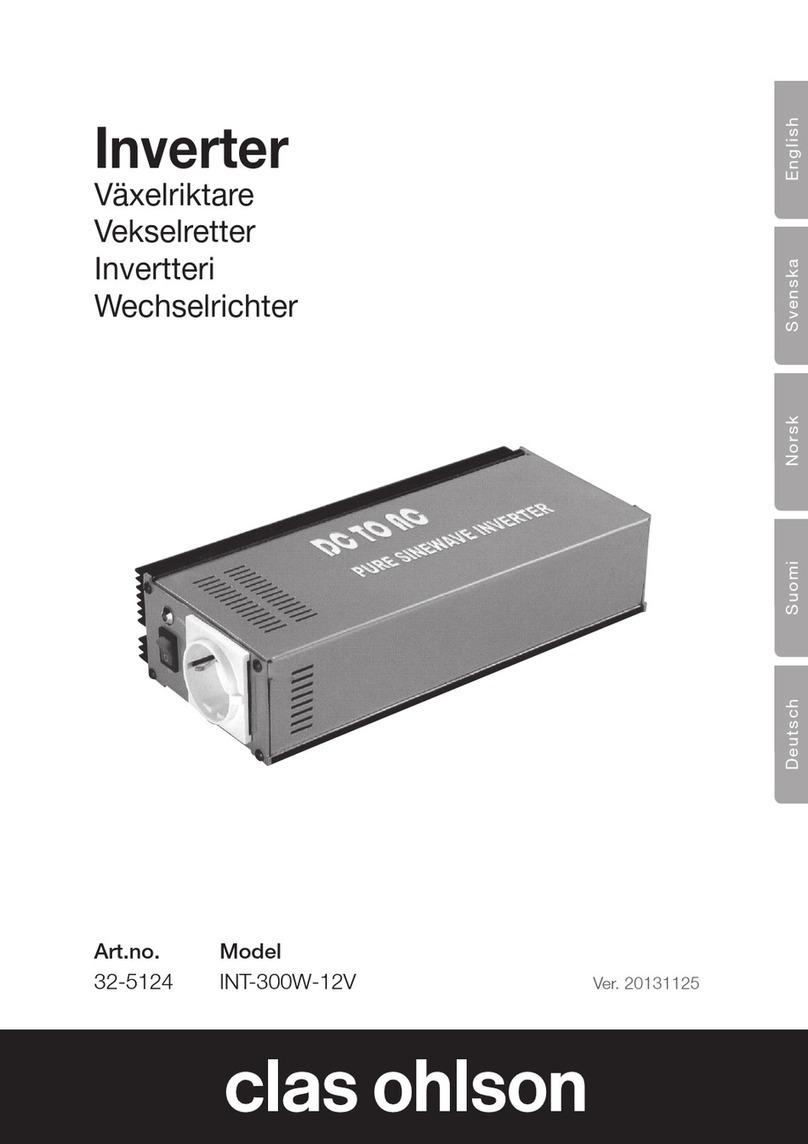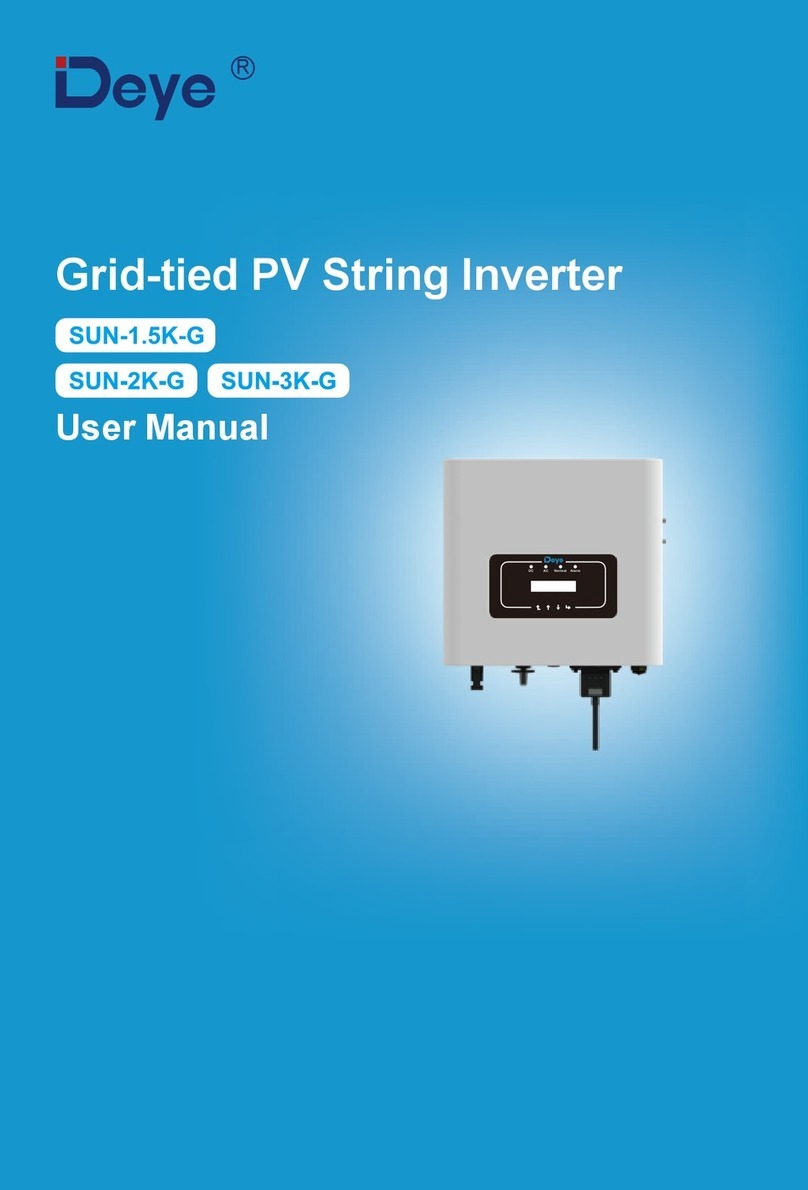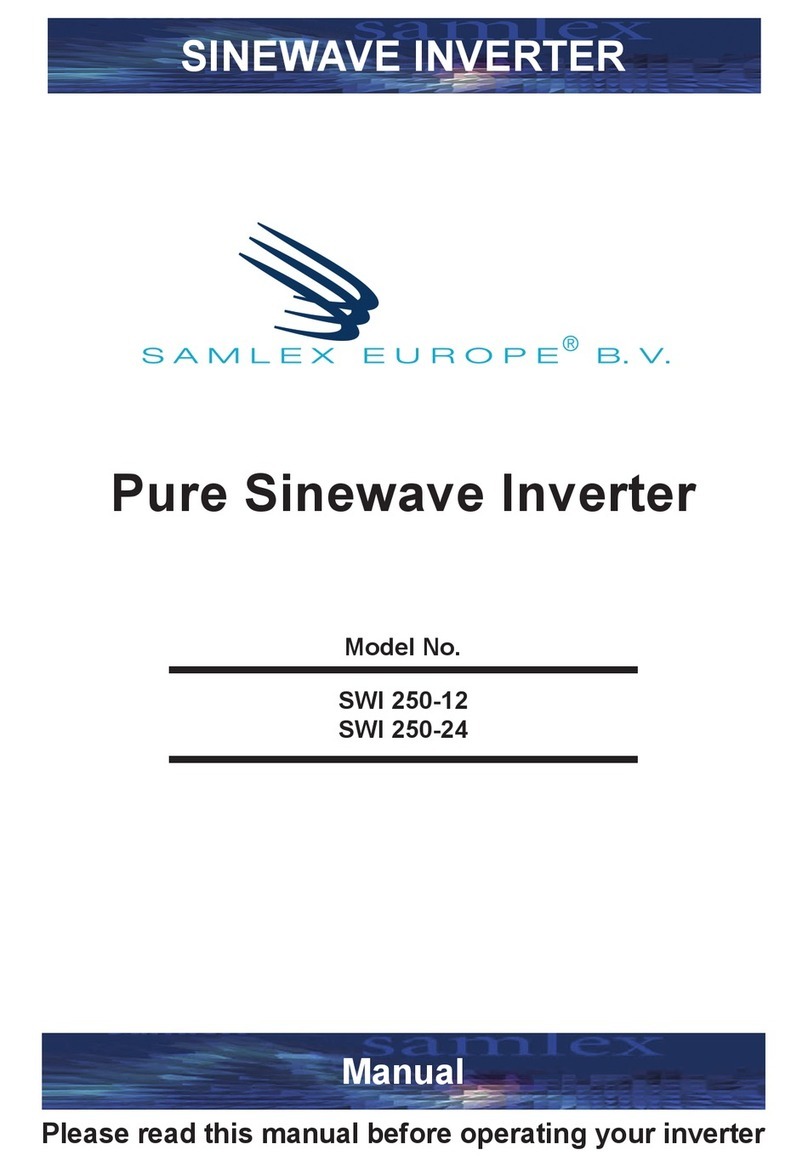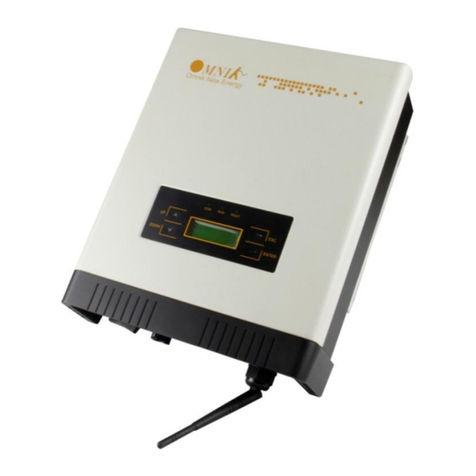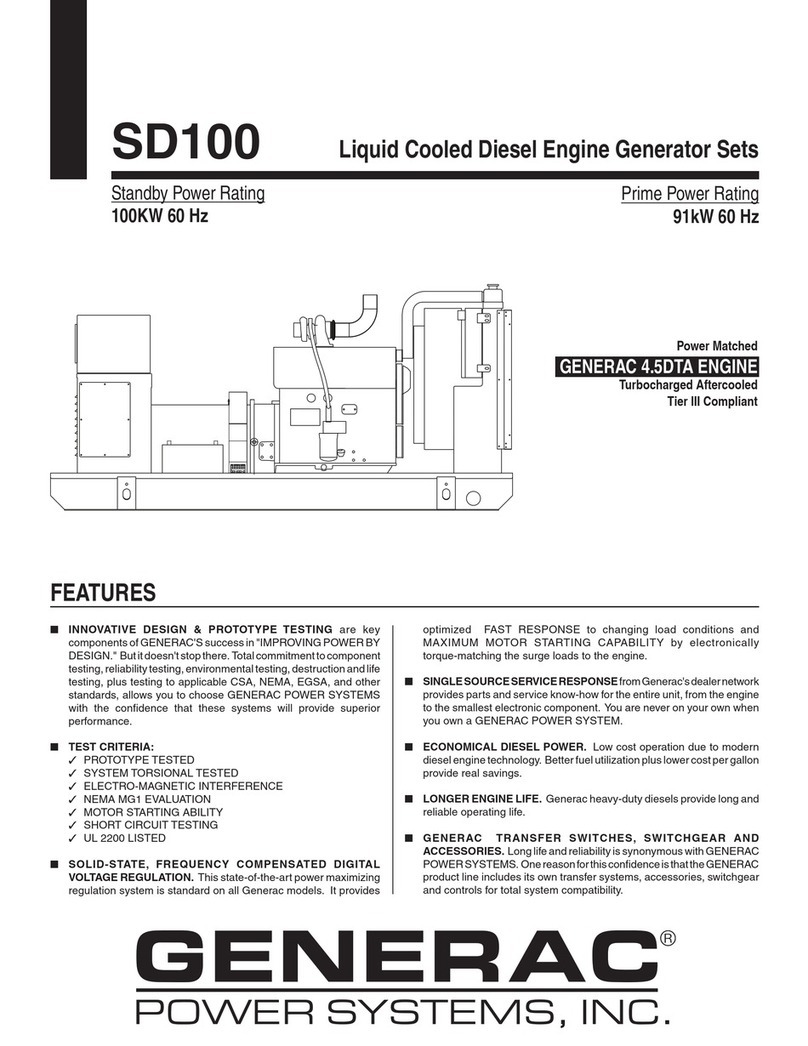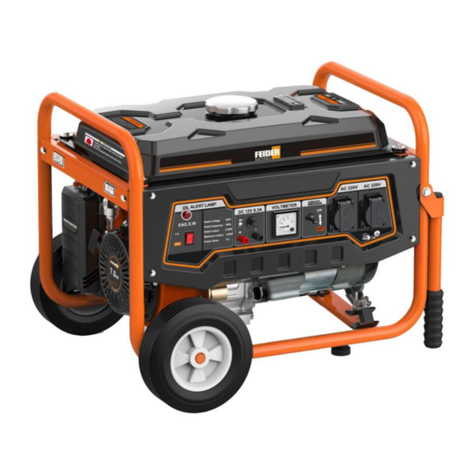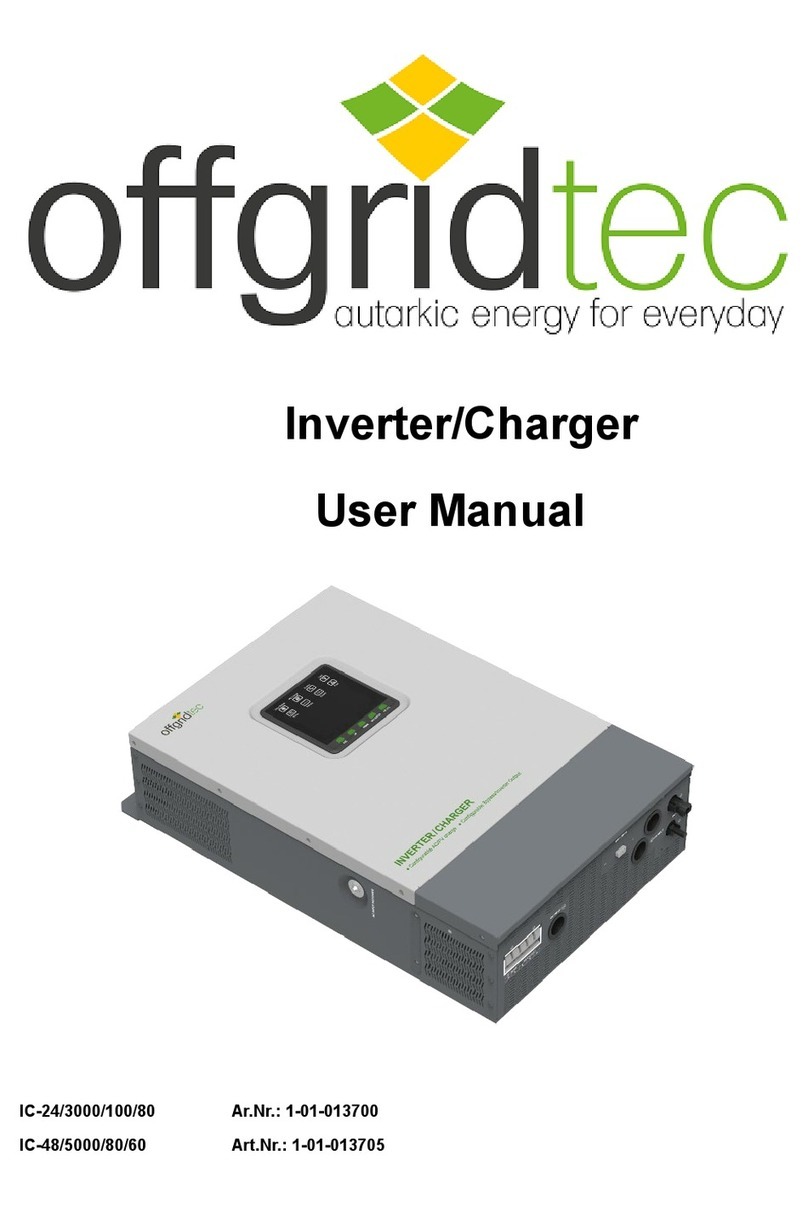Commax XDA User manual

Rack-Mount
Power Inverter
Pure Sine Wave Output
User Manual
XDA
1KVA / 2KVA / 3KVA

1

2
Contents
Page
1. SAFETY·······························································
·
P. 2
2. INTRODUCTION····················································
··········
P. 7
3. OUTLOOK····························································
············
P. 8
4. INSTALLATION·····················································
············
P. 10
5. OPERATION·························································
············
P. 13
6. SETTING ·····························································
P. 14
7. TROUBLE SHOOTING ···········································
P. 16
8. COMMUNICATION·················································
P. 18
9. SPCIFICATION······················································
P. 20
10. BLOCK DIAGRAM ················································
P. 21
INDEX

3
i. Notes on using the instruction manual
CAUTION !
Safety instruction. Failure to observe this instruction can cause
material damage and impair the function of the device.
CAUTION !
Safety instruction, relating to a danger from electrical current or
voltage. Failure to observe this instruction can cause material
damage and personal injury and impair the function of the device.
NOTE
Supplementary information for operating the device.
Please observe the following safety instructions.
ii. General safety instructions
a. Installation and Wiring Compliance
−Installation and wiring must comply with the local and national
electrical codes and must be done by a certified electrician.
b. Preventing Electrical Shock
−Always connect the grounding connection on the POWER
INVERTER to the appropriate grounding system.
−Disconnect all AC and DC side connections before working on
any circuits associated with the POWER INVERTER. Pressing
the ON / OFF button on the POWER INVERTER to OFF position
may not entirely remove dangerous voltages.
−Be careful when touching bare terminals of capacitors. The
capacitors may retain high lethal voltages even after the power
has been removed. Discharge the capacitors before working on
the circuits.
1.SAFETY

4
c. Installation Environments
−The POWER INVERTER should be installed indoor only in a well
ventilated, cool, dry environment.
−Do not expose to moisture, rain, snow or liquids of any type.
−To reduce the risk of overheating and fire, do not obstruct the
suction and discharge openings of the cooling fan.
−To ensure proper ventilation, do not install in a low clearance
compartment.
d. Preventing Fire and Explosion Hazards
−Working with the POWER INVERTER may produce arcs or
sparks. Thus, the POWER INVERTER should not be used in
areas where there are inflammable materials or gases requiring
ignition protected equipment. These areas may include spaces
containing gasoline powered machinery, fuel tanks, battery
compartments.
e. Precautions When Working with Batteries
−Batteries contain very corrosive diluted sulphuric acid as
electrolyte. Precautions should be taken to prevent contact with
skin, eyes or clothing.
−Batteries generate hydrogen and oxygen during charging
resulting in evolution of explosive gas mixture. Care should be
taken to ventilate the battery are and follow the battery
manufacturer recommendation.
−Never smoke or allow a spark or flame near the batteries.
−Use caution to reduce the risk of dropping a metal tool on the
battery. It could spark or short circuit the battery or other electrical
parts and could cause an explosion.
−Remove metal items like rings, bracelets and watches when
working with batteries. The batteries can produce a short circuit
current high enough to weld a ring or the like to metal and thus
cause a severe burn.
−If you need to remove a battery, always remove the ground
terminal from the battery first. Make sure that all the accessories
are off so that you do not cause a spark.
1. SAFETY

5
iii. POWER INVERTER Related General safety instructions
a. Preventing Paralleling of The AC Output
−The AC output of the POWER INVERTER cannot be
synchronized with another AC source and hence, it is not suitable
for paralleling.
−The AC output of the POWER INVERTER should never be
connected directly to an electrical breaker panel / load center
which is also fed from the utility power / generator. Such a
connection may result in parallel operation of the different power
sources and AC power from the utility / generator will be fed back
into the POWER INVERTER which will instantly damage the
output section of the POWER INVERTER and may also pose a
fire and safety hazard. If an electrical breaker panel / load center
is fed from an INVERTER and this panel is also required to be
powered from additional alternate AC sources, the AC power from
all the AC sources like the utility / generator / POWER INVERTER
should first be fed to a manual selector switch and the output of
the selector switch should be connected to the electrical breaker
panel / load center.
−To prevent possibility of paralleling and severe damage to the
POWER INVERTER, never use a simple jumper cable with a
male plug on both ends to connect the AC output of the POWER
INVERTER to a handy wall receptacle in the home / RV.
b. Connecting to Multi-wire Branch Circuits
−Do not directly connect to the hot side of the POWER INVERTER
to the two hot legs of the 115 / 230V AC electrical breaker panel /
load centre where multi-wire (common neutral) branch circuit
wiring method is used for distributing of AC Power. This may lead
to overloading / overheating of the neutral conductor and is a risk
of fire.
1. SAFETY

6
−A split phase transformer (Isolated or Auto transformer) of
suitable wattage rating (25% more than the wattage rating of the
POWER INVERTER) with primary of 115V AC and secondary of
115 / 230V AC (two 115V AC split phases 180 degrees apart)
should be used. The hot and neutral of the 115V AC output of the
POWER INVERTER should be fed to the primary of this
transformer and the 2 hot outputs (115V AC split phases) and
neutral from the secondary of this transformer should be
connected to the electrical breaker panel / load centre.
c. Preventing DC Input Over Voltage
−It is to be ensured that the input voltage of the POWER
INVERTER does not exceed 30VDC for 24VDC system; 60VDC
for 48VDC system; 150VDC for 125VDC System to prevent
permanent damage to the POWER INVERTER.
−Do not connect the POWER INVERTER to a battery system with
a voltage higher than the rated battery input voltage.
d. Preventing DC Input Under Voltage
−It is to be ensured that the input voltage of the POWER
INVERTER does not lower than 20VDC for 24VDC system;
40VDC for 48VDC system; 100VDC for 125VDC System to
prevent permanent damage to the POWER INVERTER.
−Do not connect the POWER INVERTER to a battery system with
a voltage higher than the rated battery input voltage.
e. Preventing Reverse Polarity on the Input Side
−When making battery connection on the input side, make sure
that the polarity of battery connection is correct (Connect the
positive (+) of the battery to the positive (+) terminal of the
POWER INVERTER and the negative (-)of the battery to the
negative (-)terminal of the POWER INVERTER). If the input is
connected in reverse polarity, the buzzer will alarm and auto
shutdown.
1. SAFETY

7
2.1. Thank you
Thank you for selecting this POWER INVERTER. It is a state-of-the-
art electronic POWER INVERTER that uses the latest technology.
2.2. System Description
The LDA series POWER INVERTER is an advanced pure sine wave
POWER INVERTER which provides reliable regulated, transient-free
AC power to sensitive equipment, ranging from computers &
telecommunication systems to computerized instrument.
Because the POWER INVERTER is constantly regulating, filtering the
output power.
The LDA series POWER INVERTER has high nonlinear load current
capability (i.e. Crest Ratio 3:1) and this is suitable for powering
Inductive Load, Capacitive Load, Resistive Load, etc.
2.3. Safety Standards
The POWER INVERTER comply with CNS-13438 class B standard.
The following products are made based on EMC standards:
(1) 1KVA, 2KVA, 3KVA (230V System): EN50091-2
(2) 1KVA, 2KVA, 3KVA (115V System): FCC PART 15 class A,IEEE
587 class A
2. INTRODUCTION

8
3.1 Front View
1. Ventilation Exit
2. Control Buttons
3. LCD Display
4. LED Indicators
5. DC Input Breaker
3.2. Rear View
1. DC Input Terminal Block
2. AC Output Socket
3. AC Output Terminal Block
4. Dry Contact (Option)
5. RS-232 Port (Option)
6. Ventilation Exit
3. OUTLOOK
2
1
3
4
2
3
4
5
6
1
5
6

9
3.3. Operation Panel
LED Indicators
& Control Buttons
No.
LED
Indication
Descriptions
1
PAGE UP
Increase
2
POWER “ON”/”OFF”
PAGE DOWN”
Decrease
3
MENU
Next Layer
RETURN
4
LED
DC INPUT (Green) ,
Supply from Battery or DC Power Supply
5
LED
INVERTER (Green)
The Green LED ON when the Inverter starts output.
6
LED
LOAD (Green),
The Green LED ON when the load is more than 5% .
7
LED
FAULT (Red) ,
The Red LED ON when the Inverter faulted
3. OUTLOOK
1
2
3
4
5
6
7

10
4.1 Unpacking and Inspection
−Unpack the packaging and check the package contents. The
shipping package contains:
A POWER INVERTER
A user manual
−Inspect the appearance of the POWER INVERTER to see if there
is any damage during transportation. Do not turn on the unit and
notify the carrier and dealer immediately if there is any damage or
lacking of some parts.
4.2 Installation and Wiring Compliance
−Installation and wiring must comply with the local and the national
electrical codes and must be done by a certified electrician.
−The DC input positive and negative terminals are isolated from
the chassis. Similarly, the neutral pole of the AC receptacles / the
neutral wire is not bonded to the chassis. System grounding to
suit the national / local electrical codes is to be undertaken by the
installer.
4.3 Preventing Electrical Shock
−Always connect the grounding connection on the POWER
INVERTER to the appropriate grounding system.
4.4 Installation Environment
−The POWER INVERTER should be installed indoor only in a well
ventilated, cool, dry environment.
−It is recommended to retain 10cm from the wall.
−Do not expose to moisture, rain, snow or liquids of any type.
−To reduce the risk of overheating and fire, do not obstruct the
suction and discharge openings of the cooling fans.
−To ensure proper ventilation, do not install in a low clearance
compartment
4. INSTALLATION

11
−Working with the POWER INVERTER may produce arcs or
sparks. Thus, the POWER INVERTER should not be used in
areas where there are inflammable materials or gases requiring
ignition protected equipment. These areas may include space
containing gasoline powered machinery, fuel tanks, battery
compartment.
4.5 Cooling By Forced Air Fan Ventilation
−The POWER INVERTER produces heat when operating. The
amount of heat produced is proportional to the amount of power
supplied by the POWER INVERTER. A DC fan is used to provide
forced air cooling of this POWER INVERTER. The fan is
thermostatically controlled and will be switched on only if the
temperature of certain hot spot inside the POWER INVERTER
rises above a certain temperature. At lower loads and / or at lower
ambient temperatures, the fan may not switch on at all. This is
normal. The unit is protected against over-temperature due to
failure of the fan / inadequate heat transfer. The AC output will be
shutdown if the hot spot inside the POWER INVERTER reaches a
certain higher temperature.
4.6 Precautions When Working with Batteries
−Batteries contain very corrosive diluted sulphuric acid as
electrolyte. Precautions should be taken to prevent contact with
skin, eyes or clothing.
−Batteries generate hydrogen and oxygen during charging
resulting in evolution of explosive gas mixture. Care should be
taken to ventilate the battery are and follow the battery
manufacturer recommendation.
−Never smoke or allow a spark or flame near the batteries.
−Use caution to reduce the risk of dropping a metal tool on the
battery. It could spark or short circuit the battery or other electrical
parts and could cause an explosion.
4. INSTALLATION

12
−Remove metal items like rings, bracelets and watches when
working with batteries. The batteries can produce a short circuit
current high enough to weld a ring or the like to metal and thus
cause a severe burn.
−If you need to remove a battery, always remove the ground
terminal from the battery first. Make sure that all the accessories
are off so that you do not cause a spark.
4.7 DC Input Connection
−Follow this procedure to connect the battery cables to the DC
Input terminals on the POWER INVERTER. Your cables should
be as short as possible (ideally, less than 10 feet / 3 meters) and
large enough cable size to handle the required current in
accordance with the electrical codes or regulations applicable to
your installation
−Cables that are not an adequate gauge (too narrow) or are too
long will cause decreased POWER INVERTER performance such
as poor surge capability and frequent low input voltage warnings
and shutdowns.
−These low input voltage warnings are due to DC voltage drop
across the cables from the POWER INVERTER to the batteries.
(Measure DC input voltage at terminal block of the Inverter side (NOT at
Battery side) and make sure the voltage is in a suitable range of the
Inverter)
−The linger and narrower these cables, the greater the voltage drop ,
then may cause under voltage.
Warning !
The installation of a fuse must be on positive cable.
Failure to place a fuse on cables running between the POWER
INVERTER and battery may cause damage to the POWER
INVERTER and will void warranty.
4. INSTALLATION

13
5.1 Start-Up:
−Press ON/OFF button for at least 2-3 seconds
−To avoid touch error or push button fault, be sure to press ON /
OFF button lasts for 2-3 seconds, till the LCD display “WELCOME
TO POWER INVERTER WORLD”
5.2 Shutdown
−Press “ON/OFF” button for at least 2-3 seconds
−To avoid touch error or push button fault, be sure to press the
button lasting for 2-3 seconds.
−If ENABLE “Turn Off confirm” page, the LCD will display “Turn off
system! Are you sure? Yes/No”, press “Page Up” button to switch
“Yes/No”, then press ”Menu” button to confirm the unit is off.
5.3 System Test:
−LCD displays ”POWER INVERTER LOOP CHECK”.
−Test before the equipment operates. If DC voltage is too low,
overheat or other abnormal status, the panel will have fault
display, the unit will auto shutdown about 5 seconds later.
5.4 Page Display Operation Status
−Press “PageUp” key , to select Page 1 to 4 to see operation
status
Page 1:
Output Voltage & Frequency
OUTPUT FREQ : 50.0HZ
VOLT : 230VAC
The built-in Soft Start function will have output
voltage start from low to high, till reach to
nominal output voltage, then have it output.
Page 2:
Output Current & Load
OUTPUT LOAD: 0.0A
LOAD: 0.0%
Page 3:
DC Input Voltage & Inverter Temperature
DC : 54V CURR: 1A
TEMP: 1A
5. OPERATION

14
Operation: Press “MENU/SELECT”button at any status page lasts for 1
second
1.
Events Record
Events:
a. Manual Turn ON: User turns on the unit
b. System Shutdown: User turns off the unit
c. Emergency OFF: Emergency cut off the unit
d. DC Volt Too Low: DC voltage is too low
e. Hardware Cut Off: DC voltage is lower than min.
working voltage forced hardware cut off.
f. DC Volt Too High: DC voltage is too high
g. Earth Fault (+): Positive electrode of DC voltage
wrongly connect to Ground
h. Earth Fault (-): Negative electrode of DC voltage
wrongly connect to Ground
i. Temp. Too High: Over temperature
j. Auto Turn On: Auto restart when DC voltage has
recovered to tolerable range
k. Output Short: Output short circuit
l. Output Fault: No Output
m. Over Load 100%: Load level is over 100%
n. Over Load 135%: Load level is over 135%
o. POWER INVERTER Fault: Abnormal output
p. VCC Fault:Abnormal hardware working voltage
q. DC Volt Fault: DC voltage is 2V higher than max.
voltage setting
r. Temperature Fault: Temperature is higher than 85℃
s. Fuse Fault: Fuse busted
2.
Output Volt: Output voltage range setting.
Range: 220V 200V240V, (or 110V 100V120V)
6. SETTING

15
3.
DC High Volt : (Alarm / Cut Off)
Range: 110V 130V / 125V
4.
DC Low Volt: Min. DC Voltage range setting: (Alarm/Cut Off)
Range: 110V83V / 88V
5.
Earth Fault (+): Set caution for Positive electrode of
DC Voltage grounding fault
6.
Earth Fault (-): Set caution for Negative electrode of DC
Voltage grounding fault
7.
Turn ON After DC Cut Off: Set Auto restore when DC
Voltage is too low to cut off
8.
Turn OFF Confirm: Set re-confirm of “Turn Off”Procedures.
9.
Date: Date Setting
Format: YYYY:MM:DD
10.
Time: Time Setting
Format: HH:MM:SS
11.
Exit Setup: Exit setting page
Clear Events Record
Press ”Page Up” button at “Events record” page till appear “No event
recorded!
6. SETTING

16
SYMPTOM
POSSIBLE CAUSE
REMEDY
When switching on,
the AC INPUT
Green LED does
not light. Buzzer is
off. There is no AC
Voltage
There is no voltage at
the DC input terminal
1. Check the continuity of the battery
input circuit.
2. Check that the battery fuse is
intact. Replace if blown.
3. Check that all connections in the
battery input circuit are tight.
“DC REVERSE”
LED lights on,
buzzer alarms or
LCD displays “DC
Reverse, CAN NOT
turn ON”, CAN
NOT power on !
Polarity of the input DC
voltage has been
reversed.
Exchange polarity and re-connect the
input wires.
LCD displays “DC
Volt too low, can’t
turn on”, cannot
power on.
DC input voltage is less
than the lowest working
voltage
1. Use true RMS reading meter to
measure if the DC Voltage
reaches to the lowest working
voltage. (24Vdc System: 20Vdc;
48Vdc System: 40Vdc; 125Vdc
System: 105Vdc)
2. Verify if DC Cable is loose.
3. Verify if DC Voltage (24V/ 48V /
125V DC) comply to the POWER
INVERTER spec.
7. TROUBLESHOOTING

17
SYMPTOM
POSSIBLE CAUSE
REMEDY
“FAULT”LED lights
on, buzzer alarms
or LCD displays
“OVERLOAD, can’t
turn on”, cannot
power on.
Permanent shut down
of the AC output due to
continuous overload
beyond the continuous
power rating of the
POWER INVERTER.
1. Reduce the load. The load is not
suitable as it requires higher
power to operate. Use a POWER
INVERTER with higher power
rating.
2. If the unit goes into permanent
overload again after resetting and
removing the load completely. Call
for Technical Support.
Buzzer alarm is
sounded. LCD
displays “Temp. too
high, can’t turn on”,
There is no AC
output.
Shut down due to over
temperature because of
fan failure or
inadequate cooling as a
result of high ambient
temperature or
insufficient air
exchange.
1. Check that the fan is working. If
not, the fan / fan control circuit
may be defective. Call Technical
Support.
2. If the fan is working, check that the
ventilation slots on the suction side
and the openings on the discharge
side of the fan are not obstructed.
3. If the fan is working and the
openings are not obstructed,
check that enough cool
replacement air is available. Also
check that the ambient air
temperature is less than 40℃.
4. Reduce the load to reduce the
heating effect. After the cause of
over heating is removed and the
unit cools down, it will reset
automatically.
7. TROUBLESHOOTING

18
8.1 Dry Contact For Alarm Remote Control
8. COMMUNICATION

19
8.2DB-9 Interface or Remote Control Data Socket
8.3. RS-232 Interface Data Setting:
Baud Rate : 2400bps
Bit Length : 8bit
End Code : 1bit
Corresponding Bit : None
RS-232 PINS Assignment:
PIN # Description I/O
6 RS232 Rx Input
9 RS232 Tx Output
7 Ground Input
TX
GND
RX
8. COMMUNICATION
This manual suits for next models
3
Table of contents
Popular Inverter manuals by other brands
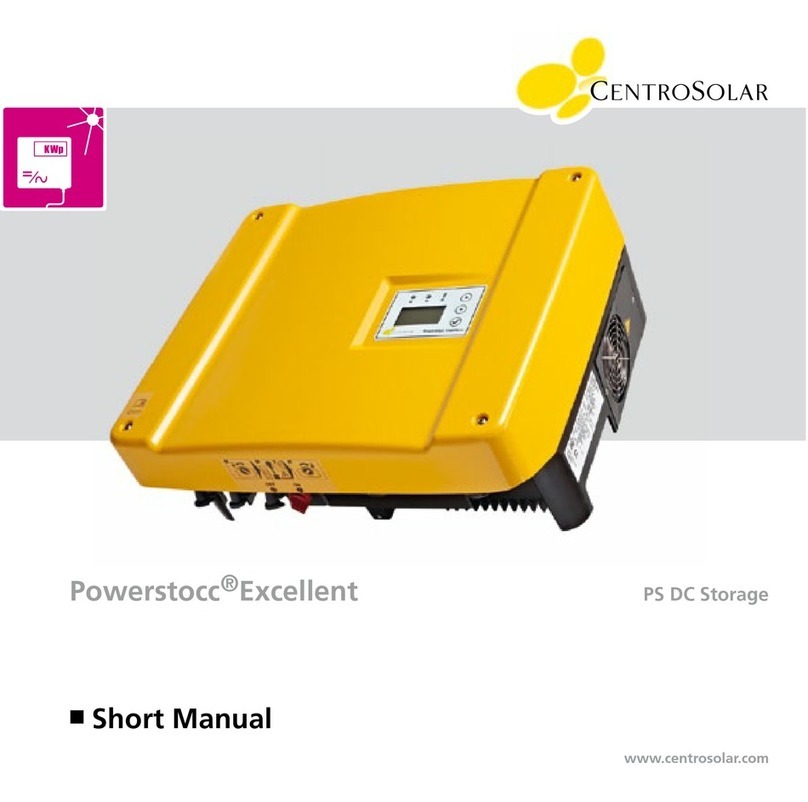
Centrosolar
Centrosolar Powerstocc ExcellentSeries Short manual
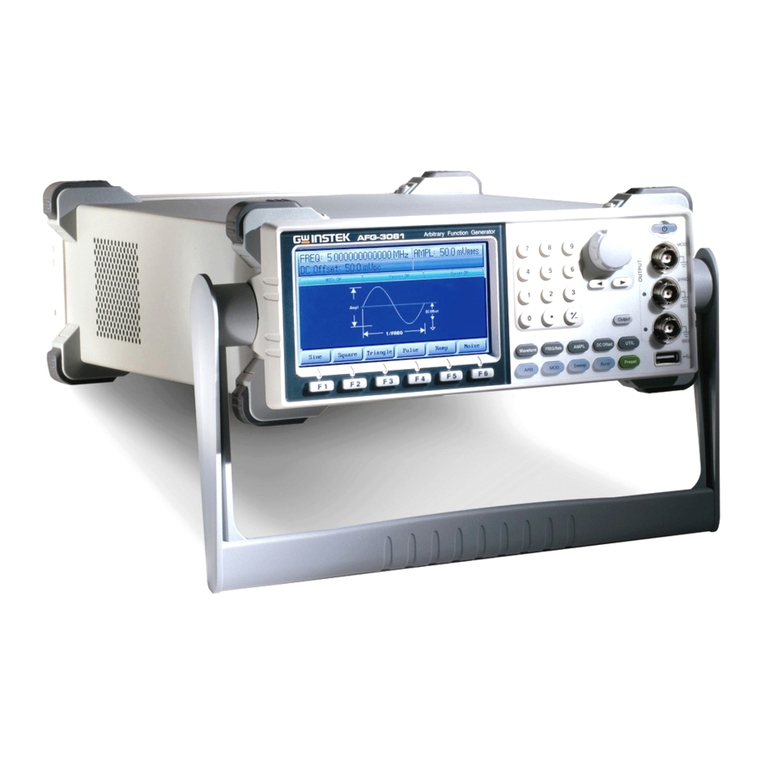
GW Instek
GW Instek AFG-3000 Series quick start guide

SSINVERTER
SSINVERTER SSI700 user manual
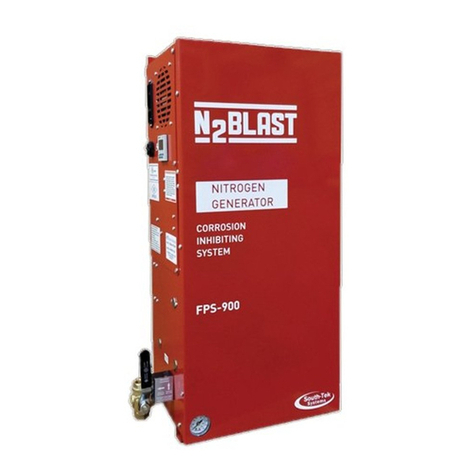
South-Tek Systems
South-Tek Systems N2Blast FPS-900 manual

CHNT Power
CHNT Power CPS SCA-T Series Installation and operation manual
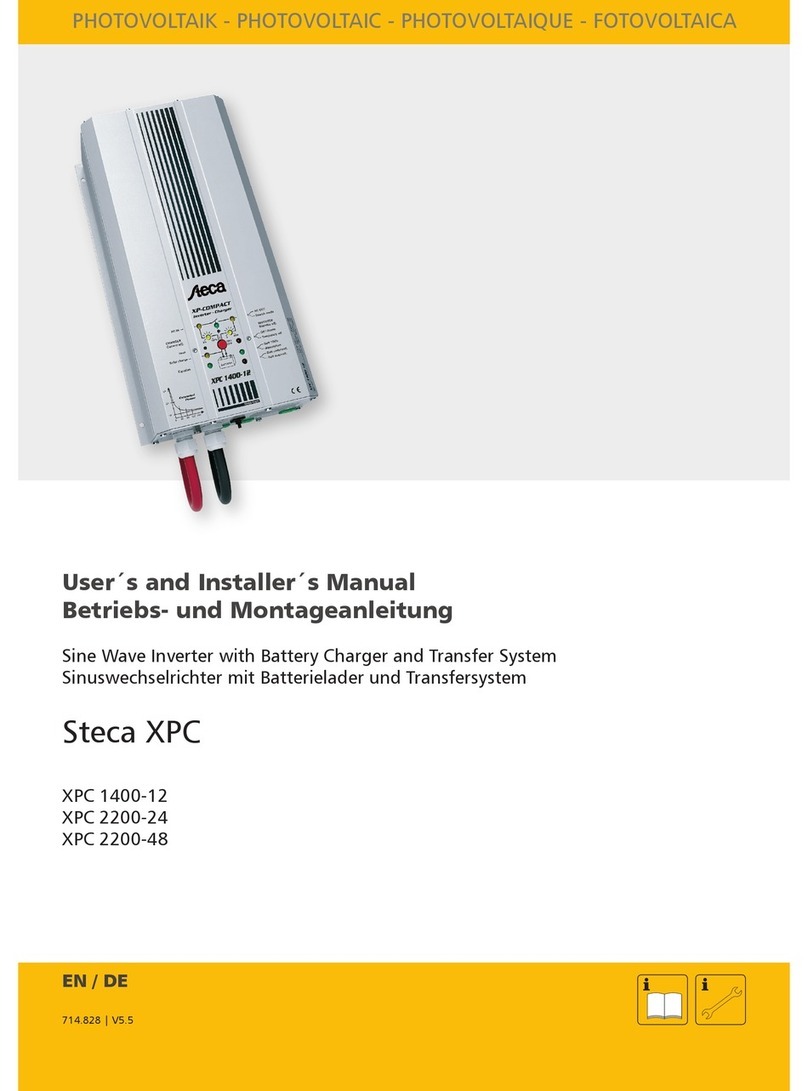
Steca
Steca XPC 1400-12 User's and installer's manual
